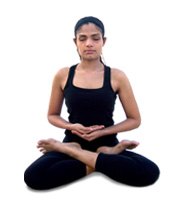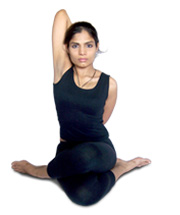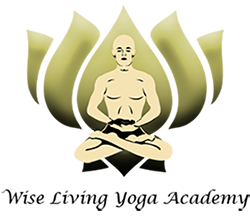From the educational point of view Yoga techniques are pegs on which to hang a lot of our clothes. The traditionalists in Yoga recommended a combination of right feelings and right attitudes with certain selected physical activities. The physical activity is no doubt selected after full consideration of its psycho-physiological value but the activity is incomplete without the attitude.
If the activity is the right kind and the attitude also enriches one’s consciousness, then the entire exercise is very satisfying and elevating.
The Yoga Institute of Santacruz, Mumbai – India (oldest organized Yoga center in the world) recommends the practices of Yoga asanas (postural training) associated with four major important groups of attitudes or feelings. These are based on scriptural authority and are known as Four Positive Bhavas of Buddhi in Shamkhya Philosophy and are as follows:
Dharma (Right Conduct & Duty)
 |
| Padmasana (Lotus Pose) |
Unlike the commonly believed connotation of “Religion” in India, the word Dharma means “Duty”. At every point in life, one needs to understand what one’s duty is in that given situation, prioritise the tasks and then move ahead. It is believed that one who is always on the path of Dharma, is saved from all sorts of pains and sufferings, etc. In fact, Yoga even outlines a hierarchy of duties, one’s first duty is to the self, then family and friends, place of work, society and finally, humanity in general.
Often we tend to neglect this hierarchy, for example over-working without eating in time or eating wrong food, not resting sufficiently, or indulging into social work without looking after the family, etc. Neglecting this hierarchy, leads to several conflicts and problems at the intra and inter-personal level. The components of this Bhava are duty, discipline, conditioning, preparedness, acceptance, commitment and also the Yamas and Niyamas.
All meditative asanas belong to Dharma Bhava.
Jnana (Knowledge or Right understanding)
 |
| Gomukhasana (Cow’s Mouth Pose) |
In Yoga, Jnana refers to Awareness and Knowledge. According to ancient Indian philosophy, all that one needs to know and understand for a meaningful life is actually present within. However, Maya or illusion keeps pulling us into the external world. We keep busy in the world outside looking for a purpose, some meaning. This leaves us confused and frustrated. Jnana in Yoga begins with awareness about self, at all levels – physical, mental, emotional and spiritual. The components of this Bhava are concentration, one pointedness, balance, body awareness, co-ordination, synchronization, training of the senses and training of the breath.
Asanas for the extremities of the body, involving upward and sideward stretches, and asanas involving twist of the spinal cord belong to Jnana Bhava. All Pranayamas and Trataka kriya are also included in this Bhava.
Vairagya (Detachment & Letting Go)
 |
| Yoga Mudrasana (Symbol of Yoga Pose) |
Commonly understood as renunciation, this Bhava actually refers to detachment. For a householder, fulfilling his duties to family is very important and renunciation doesn’t necessarily take one to detachment. Vairagya actually leads a householder to a state of being ‘in the world but not of the world’. The components of this Bhava are objectivity, humility, reducing the ego, relaxation, ‘let-go’ attitude, detachment and surrender.
All the relaxation asanas, forward bending asanas and head-low postures have been classified under Vairagya.
Aishwarya (Will power & Self-Reliance)
 |
| Ustrasana (Camel Pose) |
When one is truly on the path of the first three Bhavas, viz. Dharma, Jnana and Vairagya, the feeling of achievement, satisfaction, the knowledge yet being humble refers to as the Bhava of Aiswarya. All this adds great of confidence in one’s personality. In fact, the confidence that one may experience without the first three Bhavas, when analyzed carefully, is usually a superficial one which one puts up only as a show-off for others. This Bhava is difficult to understand theoretically, but is easier to experience through perseverance and faith. The components of Aiswarya are confidence, self-reliance, sense of achievement, effort, fortitude, freedom, strength, and forbearance.
All asanas involving backward bending of the spine and all the kriyas belong to this Bhava.
So.. the lesson here is that: only stretching, bending and twisting yourself in all possible directions will not bring about all the positive and wholesome benefits of Yoga, specially if you have a wrong frame of mind while doing it.





No Comments